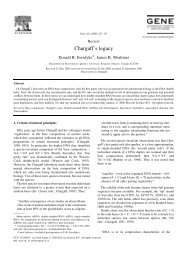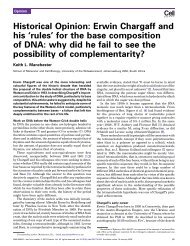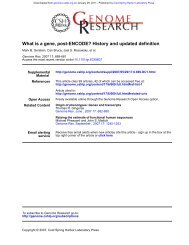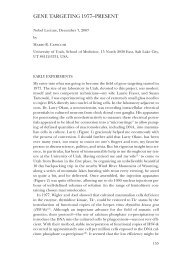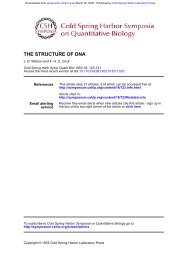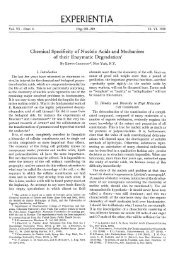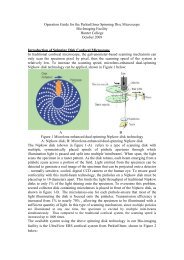So you want to Work with Giants: The BAC Vector - Biology
So you want to Work with Giants: The BAC Vector - Biology
So you want to Work with Giants: The BAC Vector - Biology
Create successful ePaper yourself
Turn your PDF publications into a flip-book with our unique Google optimized e-Paper software.
KEYWORDS: bacterial artificial chromosome, vec<strong>to</strong>r, molecular biology<br />
Special section on techniques:<br />
<strong>So</strong> <strong>you</strong> <strong>want</strong> <strong>to</strong> <strong>Work</strong> <strong>with</strong> <strong>Giants</strong>: <strong>The</strong> <strong>BAC</strong><br />
Vec<strong>to</strong>r<br />
Kevin She<br />
Pathology, University of British Columbia<br />
Submitted April 2003<br />
Introduction<br />
Bacterial Artificial Chromosome (<strong>BAC</strong>) libraries<br />
have been prominently used for the construction of<br />
physical genetic maps of many model species including<br />
Mus musculus, Arabidopsis thaliana, and of course,<br />
Homo sapiens. Also being studied are maps of economically<br />
important species such as Zea mais (corn),<br />
Oryza sativa (rice) as well as dangerous pathogens<br />
including herpes simplex virus and Epstein-Barr virus.<br />
Although <strong>BAC</strong>s were created primarily <strong>to</strong> facilitate<br />
complex genome analyses and has been an extremely<br />
valuable <strong>to</strong>ol for this purpose, there is a wide range of<br />
other uses, some of which will be discussed later in<br />
this manuscript.<br />
Development of <strong>BAC</strong> vec<strong>to</strong>rs<br />
<strong>The</strong> <strong>BAC</strong> vec<strong>to</strong>r was constructed 1 based on<br />
Escherichia coli Fac<strong>to</strong>r F’ (F’) since methods of DNA<br />
manipulation in bacteria are well established. F’ is an<br />
incompatibility group involved in E. coli chromosomal<br />
transfer and conjugative ability, which can exist as an<br />
extra-chromosomal element. <strong>The</strong> original <strong>BAC</strong> vec<strong>to</strong>r,<br />
p<strong>BAC</strong>108L, is based on a mini-F plasmid, pMBO131<br />
(Figure 1) which encodes genes essential for self-replication<br />
and regulates its copy number inside a cell. <strong>The</strong><br />
unidirectional self-replicating genes are oriS and repE<br />
while parA and parB maintain copy number <strong>to</strong> one or<br />
two for each E. coli genome. Added <strong>to</strong> the vec<strong>to</strong>r were<br />
multiple cloning sites flanked by “universal promoters”<br />
T7 and SP6, all flanked by GC-rich restriction<br />
enzyme sites for insert excision. cosN and loxP sites<br />
were cloned in (by bacteriophage l terminase and P1<br />
Cre recombinase, respectively) <strong>to</strong> permit linearization<br />
of the plasmid for convenient restriction mapping. Additionally,<br />
there is a chloramphenicol resistance gene<br />
for negative selection of non-transformed bacteria.<br />
This vec<strong>to</strong>r is capable of maintaining insert DNA<br />
BioTeach Journal | Vol. 1 | Fall 2003 | www.bioteach.ubc.ca<br />
- 69 -<br />
in excess of 300 kilobases (kb). Because there is no<br />
positive selection of clones <strong>with</strong> successful DNA fragment<br />
insertion, libraries created <strong>with</strong> p<strong>BAC</strong>108L had<br />
<strong>to</strong> be hybridization screened <strong>with</strong> whole DNA. Since<br />
the inception of <strong>BAC</strong> vec<strong>to</strong>rs, there have been many<br />
modifications intended <strong>to</strong> increase the ease-of-use as<br />
well as for use in specific systems and situations 2-5 .<br />
pBelo<strong>BAC</strong>11 2 and p<strong>BAC</strong>e3.6 6 (Figure 1) are modified<br />
<strong>BAC</strong> vec<strong>to</strong>rs based on p<strong>BAC</strong>108L and are commonly<br />
used as a basis for further modification.<br />
pBelo<strong>BAC</strong>11<br />
<strong>The</strong> primary characteristic of pBelo<strong>BAC</strong>11 is<br />
the addition of a lacZ gene in<strong>to</strong> the multiple cloning<br />
site 2 of p<strong>BAC</strong>108L. On plates supplemented <strong>with</strong> Xgal/IPTG,<br />
an intact lacZ gene encodes b-galac<strong>to</strong>sidase<br />
which catalyses the supplemented substrate in<strong>to</strong> a blue<br />
substance. Successful ligation of insert DNA in<strong>to</strong> the<br />
vec<strong>to</strong>r inactivates lacZ; hence, white colonies indicate<br />
the presence of a successful vec<strong>to</strong>r-insert ligation. However,<br />
pBelo<strong>BAC</strong>11 is still a low-copy number plasmid<br />
from the presence of parA and parB.<br />
p<strong>BAC</strong>e3.6<br />
p<strong>BAC</strong>e3.6 is also based on p<strong>BAC</strong>108L but is<br />
more highly modified than pBelo<strong>BAC</strong>11 6 . In order <strong>to</strong><br />
address the issue of low plasmid copy numbers, the P1<br />
replicon in F’ was deleted and a removable high copy<br />
number replicon originating from an inserted pUC19<br />
was introduced. Additionally, a different positive selection<br />
mechanism from blue/white selection used in<br />
pBelo<strong>BAC</strong>11 is employed. p<strong>BAC</strong>e3.6 includes a 2.7<br />
kb pUClink stuffer fragment flanked by two sets of six<br />
restriction sites <strong>with</strong>in a sacB region. <strong>The</strong> sacB gene<br />
product is levansucrase, which converts sucrose, supplemented<br />
in the media, <strong>to</strong> levan, which is <strong>to</strong>xic <strong>to</strong> E.<br />
coli host cells. Hence, if the vec<strong>to</strong>r is re-ligated <strong>with</strong>out
an insert, the functional sacB produces levansucrase<br />
and the cells die before forming colonies. Successful<br />
ligation of an insert in<strong>to</strong> the vec<strong>to</strong>r increases the distance<br />
from the promoter <strong>to</strong> the coding region of sacB,<br />
disrupting <strong>to</strong>xic gene expression in the presence of<br />
sucrose.<br />
Other <strong>BAC</strong> vec<strong>to</strong>rs<br />
In addition <strong>to</strong> the commonly used pBelo<strong>BAC</strong>11<br />
and p<strong>BAC</strong>e3.6 vec<strong>to</strong>rs, there are many specialized <strong>BAC</strong><br />
vec<strong>to</strong>rs carrying a variety of different combinations of<br />
drug resistance genes. Also, many different selection<br />
mechanisms and markers are available. Modification of<br />
cloning sites (unique restriction endonuclease sites) are<br />
also common as are the addition of genes and promoters<br />
specific <strong>to</strong> different strains of bacteria.<br />
Why <strong>BAC</strong>s?<br />
DNA is the basic code that determines how a terrestrial<br />
organism functions and the manipulation of<br />
DNA is a well-established field <strong>with</strong> many different<br />
techniques and applications. <strong>The</strong> underlying premise<br />
in working <strong>with</strong> DNA is the ability <strong>to</strong> modify and amplify<br />
the sequence of interest. <strong>The</strong>re are many methods<br />
of managing and amplifying DNA and many take<br />
advantage of the rapid and controllable biosynthetic<br />
ability of bacteria. Phages, viruses that infect bacteria,<br />
were a commonly used system that could produce very<br />
pure DNA of interest. However, it could be difficult<br />
<strong>to</strong> work <strong>with</strong> and the maximum size of each non-virus<br />
DNA fragment is usually limited 7 . Plasmids are<br />
double stranded DNA vec<strong>to</strong>rs that are maintained and<br />
replicated in bacteria, which are easy <strong>to</strong> manipulate<br />
and maintain. However, the drawback of plasmids is<br />
that their non-vec<strong>to</strong>r insert size limit is around 10 kilobases<br />
(kb) 8 . Cosmids are essentially plasmids <strong>with</strong><br />
at least one cohesive end site (cos) from a bacteriophage<br />
and require viral packaging prior <strong>to</strong> transfection<br />
in<strong>to</strong> bacteria. Cosmids can accommodate non-vec<strong>to</strong>r<br />
inserts ranging from 5 kb <strong>to</strong> 23 kb 9 . Inserts up <strong>to</strong> 35<br />
kb can be achieved, albeit at a sacrifice of packaging<br />
and transformation efficiency (personal observation) which are<br />
critical for library construction. However, even the<br />
increased maximum insert size of a cosmid system is<br />
insufficient or cumbersome for the study of a cluster<br />
of bacterial genes, large double-stranded DNA viral<br />
genomes, genes encoding non-ribosomal polypeptide<br />
synthetic proteins, or constructing physical maps of<br />
whole genomes.<br />
<strong>BAC</strong>s vs YACs<br />
Yeast artificial chromosomes (YAC) can accommodate<br />
insert sizes in excess of 2 megabases (Mb)<br />
which vastly overcome the size limitation of previous<br />
vec<strong>to</strong>rs. However, yeast spheroplast transformation is<br />
<strong>So</strong> You Want To <strong>Work</strong> With <strong>Giants</strong><br />
- 70 -<br />
relatively inefficient, and large amounts of DNA are<br />
required for library construction 10 . YAC DNA, in addition,<br />
is linear and can be difficult <strong>to</strong> isolate intact due<br />
<strong>to</strong> its susceptibility <strong>to</strong> shear. Most importantly, YAC<br />
clones are often unstable and chimeric 11 in nature and<br />
sequences <strong>with</strong> repetitious elements are prone <strong>to</strong> rearrangement<br />
12 or are un-clonable.<br />
Bacterial artificial chromosomes overcome many<br />
of the problems involved <strong>with</strong> YACs 1 . <strong>BAC</strong>s can be<br />
transfected in<strong>to</strong> E. coli by electroporation at efficiencies<br />
up <strong>to</strong> 100 times greater than yeast transformation. <strong>BAC</strong><br />
DNA exists in supercoiled circular form that permits<br />
easy isolation and manipulation <strong>with</strong> minimal breaking.<br />
In addition, clones can be effortlessly isolated via<br />
miniprep alkaline lysis and directly re-introduced in<strong>to</strong><br />
bacterial cells. Importantly, bacterial recombination<br />
systems are well characterized and recombination<br />
deficient strains of E. coli are readily available. It is<br />
not surprising, then, that <strong>BAC</strong> DNA is very stable, a<br />
trait that is aided by the low copy numbers maintained<br />
in each cell. However, there are <strong>BAC</strong> vec<strong>to</strong>rs that can<br />
attain very high copy numbers while maintaining DNA<br />
stability 6 . One drawback of <strong>BAC</strong> vec<strong>to</strong>rs compared<br />
<strong>to</strong> YAC vec<strong>to</strong>rs is that the maximum insert size that<br />
<strong>BAC</strong>s can accommodate merely exceeds about 300kb<br />
although clones in the mid-300 kb range are obtainable.<br />
Additionally, the number of successfully generated<br />
clones decreases when attempting <strong>to</strong> achieve higher<br />
insert sizes (personal observation) and there has been suggestion<br />
that there are species-specific library insert-size<br />
limitations based on base-pair content and sequence<br />
dissimilarities 13 .<br />
Making Your Own<br />
<strong>BAC</strong> vec<strong>to</strong>rs are primarily used in the construction<br />
of libraries, however, <strong>BAC</strong> vec<strong>to</strong>rs have also been used<br />
in other applications such as <strong>to</strong> study and modify complete<br />
double-stranded DNA viruses 3, 5 which are <strong>to</strong>o<br />
large <strong>to</strong> fit in<strong>to</strong> a plasmid or cosmid vec<strong>to</strong>r. In such<br />
cases, many of the techniques involved in manipulating<br />
plasmids can also be applied <strong>to</strong> <strong>BAC</strong> vec<strong>to</strong>rs.<br />
Nonetheless, owing <strong>to</strong> the large size of <strong>BAC</strong> plasmids<br />
there are special considerations and techniques, some<br />
of which will be briefly described.<br />
<strong>The</strong>re are a number of pro<strong>to</strong>cols for <strong>BAC</strong> library<br />
construction on the internet, available both at<br />
academic institutions as well as commercial services.<br />
One pro<strong>to</strong>col from an academic institution can be found<br />
here: http://www.tree.caltech.edu/pro<strong>to</strong>cols/<strong>BAC</strong>_<br />
lib_construction.html. A <strong>BAC</strong> library is a collection<br />
of clones that theoretically should have several-fold<br />
coverage of the genome of interest, thus the library<br />
should represent every nucleotide in that genome.
Figure 1 Comparison of the original <strong>BAC</strong> vec<strong>to</strong>r and a more recent widely used vec<strong>to</strong>rs<br />
Step 1: pick <strong>you</strong>r vec<strong>to</strong>r<br />
<strong>The</strong> first step is <strong>to</strong> choose an appropriate vec<strong>to</strong>r<br />
from the wide variety of F’ based plasmids. p<strong>BAC</strong>108L,<br />
pBelo<strong>BAC</strong>11, and p<strong>BAC</strong>e3.6 are available and commonly<br />
used; hence, these are well characterized for<br />
their stability <strong>with</strong>in different hosts, their cloning efficiency<br />
<strong>with</strong> DNA from different species, and other<br />
practical characteristics. However, available vec<strong>to</strong>rs<br />
may not suitable for <strong>you</strong>r needs and may require modification.<br />
An important consideration is in choosing a<br />
plasmid that is maintained at a low copy-number or a<br />
high copy-number. Low copy-number plasmids tend<br />
<strong>to</strong> be more stable than high copy-number plasmids in<br />
that there are lower percentages of recombined clones<br />
in each ligation reaction. Long term stability of clones<br />
is not significantly different between the two types of<br />
plasmids. If <strong>you</strong>r application requires a large amount of<br />
DNA or is throughput dependent, the increased number<br />
of recombined clones may be reasonable trade-off. If<br />
however, <strong>you</strong>r application is in<strong>to</strong>lerant of false positives<br />
or false negatives, using a low copy-number<br />
plasmid may be advisable.<br />
Positive selection mechanisms is another point of<br />
deliberation, although many of the high-end au<strong>to</strong>mated<br />
colony pickers and sorters are able <strong>to</strong> use colour <strong>to</strong><br />
determine which colonies <strong>to</strong> pick, if <strong>you</strong> are using an<br />
au<strong>to</strong>mated system, a <strong>to</strong>xic positive selection system<br />
such as sacB may be more appropriate. Antibiotic selection<br />
should also be considered based on the bacterial<br />
host that <strong>you</strong> are using. DH10B is a well-characterized<br />
recombination deficient E. coli that is often used <strong>with</strong><br />
p<strong>BAC</strong>108L, pBelo<strong>BAC</strong>11, p<strong>BAC</strong>e3.6, and their derivatives.<br />
However, if <strong>you</strong> are investigating or screening<br />
protein expression, DH10B may be an inappropriate<br />
production host or may only be an intermediate<br />
host. Chloramphenicol is a fairly standard resistance<br />
marker, as is ampicillin or apramycine. However, different<br />
antibiotics are effective <strong>to</strong> varying degrees, vary<br />
in mammalian <strong>to</strong>xicity, or may not be compatible <strong>with</strong><br />
<strong>you</strong>r host bacteria. Chloramphenicol and hygromycin<br />
are relatively more hazardous <strong>to</strong> humans, and ampicillin<br />
allows satellite colony growth, while apramycine<br />
- especially in conjunction <strong>with</strong> sacB/sucrose selection<br />
- is relatively more effective. <strong>The</strong> relative cost<br />
between different antibiotics may also be a fac<strong>to</strong>r in<br />
<strong>you</strong>r decision.<br />
Step 2: select <strong>you</strong>r DNA<br />
Once <strong>you</strong> have chosen <strong>you</strong>r vec<strong>to</strong>r, <strong>you</strong> will have<br />
<strong>to</strong> size-select <strong>you</strong>r DNA. <strong>The</strong> primary difficulty in this<br />
step is <strong>to</strong> prevent shearing or other degradation of the<br />
DNA. Shear forces will not only result in damaged<br />
DNA ends, affecting its ability <strong>to</strong> ligate in<strong>to</strong> a restriction<br />
site on the vec<strong>to</strong>r, but also decrease the maximum<br />
insert size possible for the library. <strong>The</strong> most common<br />
method is <strong>to</strong> embed the cells containing the genome<br />
of interest in low-melting point agarose followed by<br />
digestion <strong>with</strong> lysozyme and proteinase K. <strong>The</strong> addition<br />
of spermine/spermidine is recommended by many pro<strong>to</strong>cols,<br />
but their benefit in reducing DNA degradation is<br />
debatable. Treatment method and incubation times will<br />
depend greatly on the characteristics of the embedded<br />
cells as well as their concentration. Cells from different<br />
strains of bacteria and cells from different species<br />
may have vastly different characteristics. After lysis<br />
treatment, the genomic DNA of interest should be free<br />
from potentially degradative enzymes and in a shearresistant<br />
environment (in the agarose “plugs”). <strong>The</strong>re<br />
are also methods of isolating the DNA in liquid, but<br />
damage from shear forces will greatly decrease both the<br />
quality and the maximum size of the DNA. However,<br />
some applications may require such a method, such as<br />
BioTeach Online Journal | Vol. 1 | Fall 2003 | www.bioteach.ubc.ca<br />
- 71 -
extraction of DNA from soil 14, personal observation .<br />
Step 3: clone in<strong>to</strong> a vec<strong>to</strong>r<br />
<strong>The</strong> most efficient method of cloning in<strong>to</strong> a vec<strong>to</strong>r<br />
is <strong>to</strong> make use of the unique restriction sites in the<br />
multiple cloning site. Many of these restriction endonuclease<br />
sites result in overhangs which increases<br />
cloning efficiency, although blunt-end ligations are<br />
also possible. In order <strong>to</strong> generate mixed DNA of the<br />
desired size, the DNA plugs have <strong>to</strong> undergo partial<br />
digestion <strong>with</strong> a restriction enzyme corresponding <strong>to</strong><br />
the restriction site on the vec<strong>to</strong>r that <strong>you</strong> wish <strong>to</strong> clone<br />
in<strong>to</strong>. Since different genomic DNA have different distributions<br />
of restriction sites the amount of restriction<br />
enzyme and the reaction time required <strong>to</strong> generate DNA<br />
of the appropriate size will differ. Indeed, genomic<br />
DNA in different batches of plugs will respond differently<br />
<strong>to</strong> restriction enzyme digestion. Commonly, <strong>to</strong><br />
determine conditions <strong>to</strong> generate DNA of the desired<br />
size, a small amount of DNA plugs will be chopped<br />
up, and aliquots subjected <strong>to</strong> either varying amounts<br />
of restriction enzyme or <strong>to</strong> a set amount of enzyme but<br />
treated for different lengths of time. A wide range of<br />
conditions may have <strong>to</strong> be tried in order <strong>to</strong> generate a<br />
successful ligation reaction <strong>to</strong> generate the library. It is<br />
not surprising that it is easier <strong>to</strong> generate libraries <strong>with</strong><br />
a smaller mean insert size than a library <strong>with</strong> a larger<br />
mean insert size. Additionally, libraries <strong>with</strong> smaller<br />
mean insert sizes tend <strong>to</strong> have a higher number of<br />
clones. Minimum mean insert size will depend on the<br />
intended application of the library or the estimated size<br />
of the genes/pathways of interest.<br />
Since the maximum size that a standard agarose<br />
gel can resolve is about 40 kb, an alternative method<br />
will be required <strong>to</strong> separate and visualize DNA in<br />
the desired 100 <strong>to</strong> 300 kb range. Con<strong>to</strong>ur-clamped<br />
Homogenous Electric Field – Pulsed Field Gel Electrophoresis<br />
(CHEF-PFGE) is a method capable of<br />
separating DNA by size <strong>to</strong> well over 10 Mb (10,000<br />
kb) and is commonly used <strong>to</strong> visualize DNA used in<br />
<strong>BAC</strong> creation as well as the <strong>BAC</strong> clones themselves.<br />
Although the theory of PFGE is a matter of debate,<br />
it is unders<strong>to</strong>od that DNA above 30 <strong>to</strong> 50 kb migrate<br />
<strong>with</strong> the same mobility under continuous field electrophoresis.<br />
However, if the DNA is forced <strong>to</strong> change<br />
direction during electrophoresis (i.e., if the electric<br />
field moves), smaller sized DNA will begin moving<br />
in the new direction more quickly than larger DNA,<br />
thus the larger DNA lags behind and the smaller DNA<br />
is separated out 15 . <strong>The</strong>re are many commercial set-ups<br />
available and information on program settings is available<br />
16 although empirically determining the correct<br />
parameters such as separation area, field strength, pulse<br />
time, re-orientation angle, agarose concentration, and<br />
temperature will likely be required.<br />
<strong>So</strong> You Want To <strong>Work</strong> With <strong>Giants</strong><br />
- 72 -<br />
Commonly, the PFGE-run <strong>with</strong> the partially digest<br />
plugs will be set so that 150-250 kb range and 250-350<br />
kb range (if the intended size of the <strong>BAC</strong> clones is<br />
from 100 <strong>to</strong> 200 kb) is spread over about 1 cm each.<br />
Preferably, <strong>with</strong> smaller and larger DNA separated over<br />
a much greater distance. <strong>The</strong> two ranges (150-250 kb,<br />
250-350 kb) are excised from the gel. <strong>The</strong> two main<br />
reasons for this are that (1) by “focusing” on the desired<br />
size range, a higher concentration of DNA can be eluted<br />
from the gel and (2) by having DNA of undesired sizes,<br />
especially smaller fragments, more separated there is<br />
less contamination of small fragments in the DNA of<br />
interest. From a practical standpoint, the 150-250 kb<br />
region on the gel will contain a range of DNA sizes<br />
mostly in the 100 kb <strong>to</strong> 300 kb range. Since smaller<br />
DNA fragments have an increased likelihood of inserting<br />
in<strong>to</strong> a vec<strong>to</strong>r upon library ligation, in order <strong>to</strong><br />
maintain a high mean insert size in the library, care<br />
should be taken <strong>to</strong> avoid the presence of small DNA<br />
fragments.<br />
<strong>The</strong>re are two main approaches <strong>to</strong> recovering the<br />
size-selected DNA. Agarase is an enzyme that degrades<br />
polymerized agarose. Although this magnificently prevents<br />
shearing, the enzyme can be expensive and the<br />
buffers needed may interfere <strong>with</strong> the function of the<br />
ligase enzyme. Electroelution of DNA from the gel<br />
excision is another method of recovering the DNA<br />
fragments. Although there is theoretically increased<br />
shear damage, the practical results are insignificant,<br />
especially when fac<strong>to</strong>ring in the cost of agarase. <strong>The</strong><br />
importance of recovering the DNA in high concentration<br />
is that precipitation and resuspension in a smaller<br />
volume will greatly degrade the DNA, again, through<br />
shearing forces. It is, however, acceptable <strong>to</strong> concentrate<br />
the DNA through dialysis.<br />
<strong>The</strong> vec<strong>to</strong>r should be prepared by restriction<br />
enzyme digestion at the intended restriction site (the<br />
same or compatible enzyme that the genomic DNA was<br />
partially digested <strong>with</strong>) followed by phosphatase treatment.<br />
Calf intestinal alkaline phosphatase and shrimp<br />
alkaline phosphatases are commonly used. Depending<br />
on the restriction enzyme used, the size of the insert<br />
DNA, and the ligation reaction volume, the ligation<br />
setup should have between 3:1 <strong>to</strong> 10:1 molar ratio of<br />
vec<strong>to</strong>r <strong>to</strong> insert. A wide range of vec<strong>to</strong>r <strong>to</strong> insert ratios<br />
may have <strong>to</strong> be tried in order <strong>to</strong> generate a successful<br />
ligation. Ligation reactions are usually carried out at<br />
16 o C overnight.<br />
Step 4: transformation in<strong>to</strong> a host<br />
After the ligation reaction is finished, transformation<br />
in<strong>to</strong> an E. coli host is trivial, although the<br />
amount of DNA <strong>to</strong> be transformed and the amount of<br />
bacteria <strong>to</strong> transform in<strong>to</strong> may have <strong>to</strong> be empirically<br />
determined for each ligation reaction in order <strong>to</strong> maxi-
mize the titre of the library. Regeneration and plating<br />
pro<strong>to</strong>cols are readily available. If <strong>you</strong> are lucky (or just<br />
plain good), <strong>you</strong> now have a <strong>BAC</strong> library!<br />
A consideration when working <strong>with</strong> <strong>BAC</strong> clones<br />
is that they tend <strong>to</strong> be much larger than plasmid or<br />
cosmid clones. PCR based manipulations, such as when<br />
screening or sequencing, may require more clonal DNA<br />
and may require agents such as DMSO or betaine <strong>to</strong><br />
disrupt secondary structure.<br />
Applications<br />
<strong>BAC</strong>s are useful for the construction of genomic<br />
libraries but their range of use is vast. Application<br />
of <strong>BAC</strong>s as <strong>to</strong>ols span basic science, economically<br />
rewarding industrial research, and fields as prosaic<br />
as animal husbandry. Related <strong>to</strong> genomic analyses,<br />
the ease <strong>with</strong> which phylogenetic lineage determination<br />
between species has been vastly aided by easily<br />
manipulated and easily sequenced 17 <strong>BAC</strong> libraries 14 .<br />
Also related and aided by <strong>BAC</strong> libraries is the study<br />
of horizontal gene transfer 18 and since bacterial genes<br />
are usually clustered, the ability of <strong>BAC</strong> vec<strong>to</strong>rs <strong>to</strong><br />
accommodate large inserts has allowed the study of<br />
entire bacterial pathways. Of academic interest is the<br />
definition of what constitutes a minimal genome - <strong>BAC</strong><br />
vec<strong>to</strong>rs because of their accommodation of large insert<br />
sizes and, more importantly, their stability are marvellous<br />
<strong>to</strong>ols for this area of investigation. <strong>The</strong> biosphere<br />
is dominated by micro-organisms 19 however, only a<br />
minuscule fraction has been studied because the vast<br />
majority of micro-organisms or either uncultureable<br />
or are termed viable- but uncultureable. By isolating<br />
DNA directly from soil or from marine environments,<br />
the “metagenomes” of these organisms can be cloned<br />
in<strong>to</strong> <strong>BAC</strong> vec<strong>to</strong>rs and indirectly studied 14 .<br />
Indeed, like the unidentified therapeutic compounds<br />
in jungle flora, tiny micro-organisms are a<br />
potentially gargantuan source of antibiotic molecules.<br />
It stands <strong>to</strong> reason that micro-organisms will produce<br />
compounds <strong>to</strong> inhibit the survival of competi<strong>to</strong>rs and<br />
millions of years of co-evolution would surely provide a<br />
bounty of these molecules. Undeniably, Actinomycetes,<br />
a common class of soil bacteria – many of which are<br />
difficult or impossible <strong>to</strong> culture, has been a major<br />
source of novel antibiotics in the previous decades.<br />
<strong>The</strong>re are several labs working on isolating biosynthetic<br />
pathways from environmental samples such as<br />
soil, marine-environments, and heavily contaminated<br />
or polluted areas. Other industrial research fields where<br />
<strong>BAC</strong> vec<strong>to</strong>rs are invaluable <strong>to</strong>ols in cataloguing novel<br />
genomes is in the discovery of novel enzymes. <strong>Work</strong><br />
has been done on identifying enzymes that are involved<br />
in biopolymer hydrolysis or even radioactive waste<br />
management. In addition <strong>to</strong> antibiotic and industrially<br />
important enzymes, <strong>BAC</strong> vec<strong>to</strong>rs have been instrumen-<br />
tal in studying large double stranded DNA viruses 3,<br />
5, 20 both from an academic viewpoint and as a <strong>to</strong>ol <strong>to</strong><br />
develop improved vaccines.<br />
Bacterial Artificial Chromosome libraries are<br />
relatively easy <strong>to</strong> generate and <strong>BAC</strong> vec<strong>to</strong>r-based<br />
clones are readily manipulated using a wide field<br />
of well-established techniques. <strong>BAC</strong>s are useful in<br />
academic research, in industrial research, and even<br />
in fields as prosaic as animal husbandry 21, 22 . Current<br />
and future work such as the developing the ability <strong>to</strong><br />
use <strong>BAC</strong> transgenic animals 23 continues <strong>to</strong> expand<br />
the versatility and the ease of use of bacterial artificial<br />
chromosomes.<br />
References<br />
1. Shizuya, H., Birren, B., Kim, UJ., Valeria, M.,<br />
Slepak, T., Tachiiri, Y., & Simon, M. 1992<br />
Cloning and stable maintenance of 300kilobase-pair<br />
fragments of human DNA in<br />
Escherichia coli using an F-fac<strong>to</strong>r-based vec<strong>to</strong>r.<br />
Proc. Natl. Acad. Sci. 89; 879-8797<br />
2. Kim, UJ., Birren, BW., Slepak, T., Mancino, V.,<br />
Boysen, C., Kang, HL., Simon, MI., & Shizuya,<br />
H. 1996 Construction and characterization of a<br />
human bacterial artificial chromosome library.<br />
Genomics 34;213-218<br />
3. Smith, GA. & Enquist, LW. 1999 A selfrecombining<br />
bacterial artificial chromosome<br />
and its application for analysis of herpesvirus<br />
pathogenesis. Proc. Natl. Acad. Sci. 97; 4873-<br />
4878<br />
4. Fu, H., & Dooner, HK. 2000 A gene-enriched<br />
<strong>BAC</strong> library for cloning large allele-specific<br />
fragments from Maize: Isolation of a 240-kb<br />
contig of the bronze region. Genome Res. 10;<br />
866-873<br />
5. Yu, D., Smith, GA., Enquist, L., & Shenk, T.<br />
2001 Construction of a self-excisable bacterial<br />
artificial chromosome containing the human<br />
cy<strong>to</strong>megalovirus genome and mutagenesis of the<br />
diploid TRL/IRL13 gene. J. Vir. 76; 2316-2328<br />
6. Frengen, E., Weichenhan, D., Zhao, B.,<br />
Osoegawa, K., van Geel, M., & Jong, PJ. 1999<br />
A modular, positive selection bacterial artificial<br />
chromosome vec<strong>to</strong>r <strong>with</strong> multiple cloning sites.<br />
Genomics 58; 250-253<br />
7. Flotte, TR. 2000 Size does matter: overcoming the<br />
adeno-associated virus packaging limit. Respir.<br />
Res. 1; 16-18<br />
8. Hershfield, V., Boywer, HW., Yanofsky, C.,<br />
Lovette, MA., & Helinksi, DR. 1974 Plasmid<br />
BioTeach Online Journal | Vol. 1 | Fall 2003 | www.bioteach.ubc.ca<br />
- 73 -
ColE1 as a molecular vehicle for cloning and<br />
amplification of DNA. Proc. Natl. Acad. Sci. 71;<br />
3455-3462<br />
9. Koukolikova-Nicola, HB., Lindenmaier, W., &<br />
Collins, J. 1988 Cosmids. Biotechnology 10;<br />
113-127<br />
10. Monaco, AP. & Larin, Z. 1994 YACs, <strong>BAC</strong>s,<br />
PACs and MACs: Artificial chromosomes as<br />
research <strong>to</strong>ols. Trends. Biotech. 67; 4566-4576<br />
11. Green, ED., Riethman, HC., Dutchik,<br />
JE., & Olson, MV. 1991 Detection and<br />
characterization of chimeric yeast artificial<br />
chromosome clones. Genomics 11; 658-669<br />
12. Ioannou, PA., & de Jong, PJ. 1996 Construction<br />
of bacterial artificial chromosome libraries<br />
using the modified P1 (PAC) system. “Current<br />
Pro<strong>to</strong>cols in Human Genetics” (Dracopoli, NC.,<br />
Haines, JL., Korf, BR., Moir, DT., Mor<strong>to</strong>n, CC.,<br />
Seidman, CE., Seidman, JG., & Smith, DR. eds)<br />
5.15; 1-24<br />
13. Rondon, MR., Raffel, SJ., Goodman, RM.,<br />
& Handelsman, J. 1998 Towards functional<br />
genomics in bacteria: Analysis of gene<br />
expression in Escherichia coli from a bacterial<br />
artificial chromosome library of Bacillus cereus.<br />
Proc. Natl. Acad. Sci. 96; 6451-6455<br />
14. Rondon, MR., August, PR., Bettermann,<br />
AD., Brady, SF., Grossman, TH., Liles,<br />
MR., Loiacono, KA., Lynch, BA., MacNeil,<br />
IA., Minor, C., Tiong, CL., Gilman, M.,<br />
& Goodman, RM. 2000 Cloning the soil<br />
metagenome: a strategy for accessing the<br />
genetic and functional diversity of uncultured<br />
microorganisms. Appl. Env. Microbiol. 66;<br />
2541-2547<br />
15. Chu, G., Vollrath, D., & Davis, RW. 1986<br />
Separation of large DNA molecules by con<strong>to</strong>urclamped<br />
homogenous electric fields. Science<br />
234; 1582-1585<br />
16. Anand, R. & <strong>So</strong>uthern, EM. 1990 Pulsed field gel<br />
electrophoresis. “Gel Electrophoresis of Nucleic<br />
Acids: A Practical Approach” (Rickwood, D., &<br />
Hames, BD., eds) 101-123<br />
17. Chen, CX. & Gmitter, FG. Jr. 1999 Direct<br />
cloning and sequencing of bacterial artificial<br />
chromosome (<strong>BAC</strong>) insert ends based on double<br />
digestion. Plant. Mol. Biol. Rep. 17; 231-238<br />
18. Hugenholtz, P. & Pace, NR. 1996 Identifying<br />
microbial diversity in the natural environment:<br />
a molecular phylogenetic approach. Trends.<br />
<strong>So</strong> You Want To <strong>Work</strong> With <strong>Giants</strong><br />
- 74 -<br />
Biotech. 14; 190-197<br />
19. Whitman, WB., Coleman, DC., & Wiebe, WJ.<br />
1998 Prokaryotes: the unseen majority. Proc.<br />
Natl. Acad. Sci. 95; 6578-6583<br />
20. Adler, H., Messerle, M., & Koszinowski,<br />
UH. 2001 Virus reconstituted from infectious<br />
bacterial artificial chromosome (<strong>BAC</strong>)-cloned<br />
murine gammaerpesvirus 68 acquires wild-type<br />
properties in vivo only after excision of <strong>BAC</strong><br />
vec<strong>to</strong>r sequences. J. Vir. 75; 5692-5696<br />
21. Anderson, SI., Lopez-Corrales, NL., Gorick,<br />
B., & Archibald, AL. 2000 A large-fragment<br />
porcine genomic library resource as a <strong>BAC</strong><br />
vec<strong>to</strong>r. Mamm. Genome 11; 811-814<br />
22. Buitkamp, J., Kollers, S., Durstewitz, G.,<br />
Fries, R., Welzel, K., Schäfer, K., Kellermann,<br />
A., & Lehrach, H. 2000 Construction and<br />
characterizatio of a gridded cattle <strong>BAC</strong> library.<br />
Anim. Genet. 31; 347-353<br />
23. Heintz, N. 2001 <strong>BAC</strong> <strong>to</strong> the future: <strong>The</strong> use of<br />
<strong>BAC</strong> transgenic mice for neuroscience research.<br />
Nature Rev. Neur. 2; 861-870



